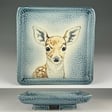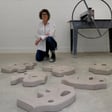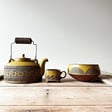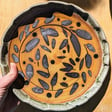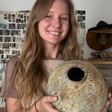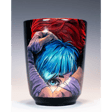Discover Your Pottery Voice
00:00:00
Speaker
Hey, real quick before we get started and get into the episode. If you want to figure out how close you are to discovering your own unique voice, I put together a free little quiz for you to see how close you are to finding your own unique voice. If you would like to take this quiz, go to shapingyourpottery.com forward slash quiz, or you can just go to shapingyourpottery.com and it'll be right there. I'll see you guys in there.
00:00:24
Speaker
If you love pottery and want to take your skills to the next level, you're in the right place. Find your own pottery style right here on Shaping Your Pottery with Nick Torres. Let's get started.
Pottery Mishaps and Lessons Learned
00:00:36
Speaker
There's something about making something that other people don't understand that makes it even more interesting.
00:00:42
Speaker
Michelle, welcome shape your pottery and share with me what's fair you have experienced that you believe many potters are heading for. Well, Nick, a few years ago, I was super excited about creating templates and stencils on a silhouette cutter.
00:00:58
Speaker
And I've been admiring Renee Lapresti's work and I learned that she had made her own stencils. And I want to get started with these new ideas that I had. So I had this upcoming trip with friends to the Pacific Northwest and I had this idea that I was going to make them each a mug.
00:01:18
Speaker
that would represent our experience that we were going to have. And so I designed this mug. I spent all this time putting it together with the Silhouette Design Studio and also with my own using Procreate. And I was really excited about the way they looked. They looked so good when they were on greenware. And then I got to the last and final stage, which was after the bisque and before the glaze. And I realized that
00:01:47
Speaker
I wasn't sure if I wanted to put clear glaze over it and I hadn't tested the underglazes to see what they would look like with and without clear glaze over them.
00:01:59
Speaker
I went ahead and I went for it. I made 10 of these mugs. So I had spent a fair amount of time making these mugs and really babying them through the drying process because they were porcelain and had shaped a special handle and things like that. And I went ahead and glazed them all with this clear glaze over the top.
00:02:18
Speaker
that totally felt like it was the right thing. It was like I was pretty secure in that decision. Well, I decided there would be one that didn't have clear glaze. That would just be like a tester to see what it would look like without the clear glaze. But I was pretty sure it was going to turn out fine. And of course, the day where I'm going with this, the day that I open up the kill, I look at the ones that have the clear glaze on them and they're all muted and faded and it looks totally meh.
00:02:46
Speaker
And the only one that ends up turning out is the one that was really my test piece, which did not have the clear glaze over the top. You know, it was one of those things where I knew that I needed a test and really in advance of doing a large project, make sure that I knew that I liked what the results would be and I just pushed forward and just lost sight of that.
00:03:08
Speaker
So that was a pretty big failure and I ended up giving all those mugs away to somebody else besides my friends, somebody else who I was like, okay, if you really want them, they're all yours. I don't love them, but you can have them. And the only one that I ended up giving away, which was actually the one that did not have the clear glaze on it. So. That is quite the story.
00:03:28
Speaker
Shaping Nation, if you have a big project, make sure to test things out beforehand so that you can give the customer or the people you're giving the Pottery Q the best piece possible.
Michelle's Journey into Pottery
00:03:39
Speaker
Tell me the story how you got started making pottery. Well, I don't have a formal art education. I mean, I've always loved to create. It's a place where I live quite frequently because it gives me such a sense of joy. And whenever I make something, whether something really simple and basic or something more complicated, I just find this, you know, almost meditative state with my work. It's just a really exciting thing for me.
00:04:09
Speaker
And I come from a family that is, you know, just there's a lot of creatives in my family. My parents are these fiercely independent entrepreneurs. They're super self-reliant. They are creative, small business owners. So in the spirit of their generation, they never hire somebody that could do something for them if they can do it themselves. So I grew up watching my dad sew and make decorative woodwork for our house and
00:04:37
Speaker
My mom still has this exquisite high altitude garden where she goes out and finds orages, plants out in the woods and brings them back to her garden and grows those at 10,000 feet. So I have a sister who's a potter. I have another sister who's a maker. I have a cousin who's a painter. So I have all these people who don't have any kind of formal art degrees but are doing all of this work that they just love to make. They're just really excited about making.
00:05:05
Speaker
You know, I mean, I still remember when I first made my first piece of pottery and my mom has saved this little ornament that I made. But honestly, it really started when I first met this potter named Peter Carner.
00:05:19
Speaker
And Peter is, was the boyfriend of my very best friend. And he lived out in this area called Cherry Creek and he had a yurt and a wood fire kiln and had an amazing setup. And I just thought, this is incredible. And I started collecting pottery around that same time because his work was gorgeous. And then I also started to admire other people's work.
00:05:45
Speaker
And as time went on, I realized that, you know, there were a lot of talented potters in this region. You know, so I right after we had a house burned down and forest fire here in Durango. And so right after that, one of the very first things that I purchased was a wood fire series from a woman named Jennifer Neff. I also found some potters in this area like Lorna Meadan and
00:06:11
Speaker
Blair and Marty Meerfeld. And then I finally happened along Tako Hashimoto's work, which is absolutely gorgeous. And it turned out that Chaco had, you know, me pottery studio here in Durango and offered classes in pottery. And I signed up for one of her classes and that's pretty much where things got started. I took a class in a community studio. I wasn't a community pottery member yet because she had a wait list and she also
00:06:40
Speaker
makes sure that people are ready to become members. And the way that she does that is by having them take several classes to make sure that they know the foundation of pottery before they're set loose in her studio. So I took some classes with her. I discovered that it was incredibly hard for me and I was not at all naturally talented at pottery.
00:07:02
Speaker
And she just made it look so easy and so, you know, just like her fingers were just like dancing on the pottery wheel. And mine, on the other hand, I felt like I had 10 thumbs, you know, it was just a really kind of awkward experience for me.
00:07:18
Speaker
I just stuck with it. I thought about quitting the first day of class. I'm not going to lie. I was just like, whoa. I'm not one of those people who was like, I fell in love with working on the wheel. It was more like I was just fighting it and fighting it. And I think what's part of what actually kept me interested was the challenge of it. Because in some ways, that challenge can actually be inspiring to make you want to keep coming back to it and try it again and again. And that's exactly what I did.
00:07:47
Speaker
kept trying, trying and trying. And finally, after some time, lots of hours on the wheel, I started to get good at it and started to feel very enjoyable for me. But it wasn't after until after a lot of practice that that occurred. So, yeah, that's how that's how things got started for me with pottery. Definitely agree with the challenge. When I first started pottery, it was like four of us that
00:08:10
Speaker
did it all at once, and I was the worst one, but I didn't like to lose, and that challenge kept me trying to get my work to get better. I'm competitive in that way too, Nick. I can totally relate with that. It's like it does help me to have other people that are like pushing me a little bit, so. Yep, definitely agree. So tell me about your time studying at the Inomi Pottery Institute.
Studying at Inomi Pottery Institute
00:08:32
Speaker
Yes, you know, Taco taught us a really sweet foundation for how to work on the wheel primarily using stoneware mid-fire stoneware. And so I didn't really have any experience with learning about porcelain.
00:08:49
Speaker
or really learning much about glaze as far as making your own glazes. But I learned a ton about the foundations, like how to make lids and how to throw off the hump and how to grow your cylinders tall and even did a little bit of hand building with her, but mostly just manipulating pieces off of the wheel.
00:09:11
Speaker
the very most important basic foundations on how to work in a studio. And really, it was her. It was what she taught me and what she showed me that led me to be able to open up my own studio because she runs a beautiful studio. And so when I did finally decide to open my own studio, I had this great role model for how to make a studio beautiful and functional and flow well and be well organized.
00:09:42
Speaker
Tell me the story about when you decided to open up your own studio. Yeah, so I always in the back of my mind thought that maybe I might do that, but I just wasn't sure. And I mean, things were so nice in the studio with Chaco and all of my friends that I had made. And I just I loved going in there. So it wasn't really until Chaco had to shut the studio down due to a family emergency and
00:10:08
Speaker
that kept her away from the country for about five months. While that occurred, I just missed throwing so much. And so I got a wheel. And I also got an inexpensive desk from the thrift store and a piece of hardy backer board and started throwing at home during that time.
00:10:28
Speaker
I didn't know what to do with the work exactly. I pretty much just saved it up. I tried to get it fired in another studio here, but it was kind of cumbersome to do that. And so I ended up just kind of saving the work until she got back and then went back to the community studio.
00:10:44
Speaker
at first for a while and then but I already had things kind of set up here so it was kind of I was in this place of limbo so one thing led to another and I decided to commit to just being here at my own studio that I had started already to create and continue to have these bonds with these people that I had developed friendships with and already had friendships with before I ever
00:11:07
Speaker
Started at you know me. So that's that's how I started my studio here And you know every year what I do is I just think of a couple of things that I want to do to improve my studio now So I just you know like last year I worked on like making my studio better with as far as health and Keeping it cleaner and then this year I added some shelves which you can see behind me So every year I just kind of add
Opening a Pottery Studio: Emotions and Decisions
00:11:34
Speaker
a little bit more
00:11:34
Speaker
What were you feeling when you finally opened up your own studio? You know, I was I was super excited about it. You know, I mean, at first I was I was unsure because I loved the community so much. And so missing out on those opportunities to talk to people when you go in the studio and to kind of look at what they're doing and things like that. So at first, you know, I was a little bit indecisive about like, did I make the right decision?
00:12:04
Speaker
But then as time went on and my friends from the studio continued to, you know, hang out with me and we continued to have this relationship and I, Chaka and I are really good friends today and so I'm always spending time with her. So I started to become more secure in my decision that it was going to be okay to not have that experience as a community member that you would get because of the other people there. And I love having the
00:12:31
Speaker
the ability to decide what I'm going to do in my own studio. Porcelain's actually kind of hard to work with, and I don't exclusively work with porcelain, but I was for a while working exclusively with porcelain because it's really hard to work in a membership studio with a lot of different clays if you're trying to work just with porcelain because that porcelain can get mixed in with other clays and then it gets just, it's no longer looks like porcelain, you know.
00:12:56
Speaker
And it's kind of, it's, there's, if I'm making a lot, I need a lot of space. And although there's, you know, it's a really, like I said, you know, it means a really nice space. Sometimes I found that I was a little bit limited in my space requirements for what I wanted to make. Now, what advice would you give to someone that wants to open their own studio?
00:13:17
Speaker
Well, I would say that if somebody had told me how much work it was going to be to open up my own studio, I might have shied away from it. I'm really glad I did it, but I think it's something you have to be mentally prepared for. I think if you want to open up your own studio, I think it's good to just take it in small steps
00:13:40
Speaker
and create some sort of a timeline for yourself of like your priorities each year. So like, for example, my priority the first year was just get a wheel and start making on that wheel. And then my next step, of course, was to get a kiln, which is a pretty huge step because that is
00:14:00
Speaker
It's expensive. It's intimidating. It made me very nervous to have something running at that temperature in my garage. And then, of course, when you get your kiln, you also have to have glazes. And so do you want to mix your own glazes? Do you want to buy manufactured glazes? So there's so many decisions that have to be made. I think it's easy to get overwhelmed. And so I think if you create
00:14:26
Speaker
Um, kind of a timeline for yourself, like, okay, I'm going to give myself the space and the time to take this step by step by step and not try to do it all at once. It's a lot more manageable. Um, so that would be my best advice. Some excellent advice, but they're absolutely love it. So let's talk about your pottery. Can you tell me a story? How you started making your native porcelain pottery that you make today?
00:14:50
Speaker
many years ago was probably like six, seven years ago, something like that. I was in my studio and I was doing something that actually allowed me to listen to a podcast. I don't really listen to a lot of music and podcasts and things like that in my studio, but every once in a while, if I'm wedging or if I'm cleaning, I'll listen to a podcast. And so I had a podcast on and I was only half listening, but I heard the person that was being interviewed
00:15:19
Speaker
say that she did something where she put her knitwear in the kiln and fired it. And I was like, what? Like it didn't make any sense to me. There was absolutely like no, like it just, you know, not having an art degree, I'm sure that other people probably were able to quickly make sense of it. But for me, I was like, I don't understand.
00:15:43
Speaker
So I kind of, but the seed was planted, right? So I kind of filed it away because it was too much to even think about for me at that point. And I was trying to keep myself from going down rabbit holes. And so I just filed it away as something that I was interested in and curious about.
00:16:01
Speaker
But I didn't have the time in my life at that point really to go and research it and, you know, start this new project because it's, you know, it is definitely, I knew it was going to be kind of a big deal to get started on something like that, but it was something once I heard about, I was like, yeah, pretty sure I'm going to try that at some point in the future. So.
00:16:19
Speaker
I returned to the idea in the last six months or so, and I started to research it. And what I discovered is there's actually not a whole lot of information out there about how to use your knitwear in your kiln and what the steps are for that. And so I just found this website.
00:16:41
Speaker
where a woman had her knitwear on her website and she was selling it, that her knit porcelain on her website. And I reached out to her, this beautiful work, I reached out to her and I said, hey, I love what you make. And turns out she makes lots of different things. She's a painter and she's made functional wear and she's definitely got a lot of different things going on.
00:17:04
Speaker
She wrote me back and she said, what do you like? And I said, I like your knit porcelain. And she said, thank you, and started to kind of engage in a conversation with me through email. And I said, you know, I'm actually thinking about starting to do this. What do you think? Would that, you know, would it be okay?
00:17:22
Speaker
how do you do it? And she said, I would be happy to mentor you through this. I'd be happy to tell you everything that I know. And basically just gave me some good instruction for how to get started. And again, just like the basic instruction for keeping it not overwhelming, just kind of keeping it simple. And then I have gone back to her
00:17:45
Speaker
and emailed her and communicated with her about some questions that I've had, and she's just been wonderful. And her name is Liz Crane, and she's been instrumental in making sure that I can do this, and it's been pretty exciting. So that's how I got started.
The Art of Knit Porcelain Pottery
00:18:01
Speaker
Absolutely love that. Shaping Nation, if you have questions about a technique that a partner is doing, reach out to them, because more than likely, they're going to answer back, and they're going to give you the steps to make that process. I absolutely love that.
00:18:15
Speaker
So now can you walk me through the steps you take when creating your native pottery?
00:18:19
Speaker
Yeah, absolutely. So the first thing that I do is I find a knitting pattern that I think will look interesting after it's been fired and also hold up to the firing. So I'm looking for something that maybe has a little bit more of an interesting technique to it that maybe is some lace work or something that has an interesting shape or something that I can ultimately shape in an interesting way.
00:18:47
Speaker
And then I knit that with cotton twine. And then after I'm done knitting it, I dip the piece in porcelain slip. That's about the consistency of milkshake, like a milkshake. And it's not a precise recipe, so just kind of have to just look at the slip.
00:19:04
Speaker
but it is porcelain. And then when I'm done, I let it dry a little bit and then I sort of wipe off the excess so that those knitting details start to come out. And then I add another layer of slip using a paintbrush that time. That layer is added for extra strength for the piece. And around this same time, I'm forming the piece, adding things like plastic bags and
00:19:29
Speaker
wrapping it over buckets and wrapping over my powdery seconds and things like that to make it interesting shape. I mean, like I didn't have a piece here, you know, like I will add like little clips, you know, in an area that I'm hoping will stay together so I don't want it to fall apart. And then I dry the piece completely and remove the materials that I used for holding the form of the piece.
00:19:54
Speaker
And I then wax the base of the piece because I'm not going to pull it out in between the bisque fire and the glaze fire. So I go ahead and wax it with a little bit of alumina hydrate in the wax substance. And that's just going to be what stays in the kiln and underneath the piece because that alumina hydrate will melt off and out of the wax and just remain on the kiln shelf.
00:20:18
Speaker
And then I fire it to cone of five in an electric kiln and then I fire. I leave it alone. I don't touch it. And then I refire it again to come five. And that's pretty much what what I do. So do you leave the.
00:20:36
Speaker
The knitted pot in the kiln for both of them, you just leave it in? That's correct. I just leave it in there. Why do you do that? Well, because I haven't gotten the courage yet to fire it all the way through a glaze firing yet, just all the way through. But I think you could probably do that. The reason that I'll touch it after the cone, after the O5, the bisque firing, is it's too fragile and it'll just basically crumble. Very interesting.
00:21:03
Speaker
that I love here in that process. That was very interesting. So something interesting I found is many of your pots are meant to be used while some are just used to create a sense of curiosity. Can you tell me more about this? Yeah. So when I first started to really appreciate pottery, one of the things that I did was I, as I mentioned earlier, I collect pieces and some of those pieces are literally intended just to be in a home and making, you know, a home look beautiful and
00:21:32
Speaker
you know, kind of curious pieces, like pieces that if you look closely at them, you know, it turns out that that form that originally maybe looks like a tree stump has these elements that also are a human body.
00:21:48
Speaker
and or pieces that you look at and you go how in the world did that artist do that? How did they make them? You know it's just it's like so fascinating to think about a person's process and so I started to collect these pieces and for it to investigate like how did this artist do this and then when you know if I had friends come over and they were like what's what do you have here I
00:22:12
Speaker
I like to tell people like this is the process that I think that this artist probably used for making this piece. And so that inspiration of what others have done and what I have in my own home from other artists has inspired me because even though I love making functional wear, I find functional wear really rewarding. I love using other people's functional wear that they've created and I love knowing that other people are using
00:22:39
Speaker
my functional wear in their home, there's another part of me that is really, feels so much satisfaction when somebody asks me, how did you make that? And I love answering that question, you know, like answering the question of what, how I made the knit porcelain is actually really exciting for me because it's a really, you know, like there's something about making something that other people don't understand that makes it even more interesting, I think, so.
00:23:07
Speaker
So I just, I think it's really nice to do both. I think it's really nice to find a way to make functional work that, you know, feels beautiful in your hand and against your lips. And that's just the right sort of weight in your hands or, you know, that makes a dinner look beautiful when plated on it. But I also love pieces that are really just for design and curiosity.
00:23:30
Speaker
How can someone build curiosity with their project? You know, it kind of comes with starting with something pretty basic and then as you're making that piece, adding elements to that piece that are unexpected. So, you know, for example, let's just take a piece of knit porcelain. You know, you could just make like a, I don't know, a muck.
00:23:54
Speaker
You could say, I'm going to try and form a mug because it's going to get fired in a kiln, and I'm going to make something that looks like it's been taken out of a kiln and is functional aware, but it's not functional aware.
00:24:05
Speaker
But then wouldn't it be cool to like also just like make the edge of that mug really rough and kind of ragged because that kind of draws the attention to another thought of like, you know, maybe this isn't actually a mug, but it looks like a mug. So it's almost like there's two, like two opposing thoughts that are coming in that make you think twice about what you're seeing.
00:24:30
Speaker
I absolutely love that. Shaping Nation, if you can find a way to build curiosity with your pottery, then it sparks ideas, not into yourself, but also into other people's minds as well. I absolutely love that.
Finding Your Unique Pottery Style
00:24:43
Speaker
So let's talk about discovering your voice. Can you tell me about the moment when you knew you were heading in the right direction with your... You know...
00:24:51
Speaker
Okay, so finding satisfaction in my work is actually kind of tough for me. I always find there's something that I want to improve upon, something that is close but not quite right. So I make something that I actually, when I make something that I actually like,
00:25:08
Speaker
That's actually pretty rare for me. I often make things that never see the light of day because I'm dissatisfied with some small part of the results. So a few years ago, I started to realize that I so I really like to illustrate my work. But what I was discovering that started to happen like a few years ago is that even though I love the act of
00:25:31
Speaker
decorating, creating stories on my work. I actually don't like having those pieces around me. They don't work for my own aesthetic. And so I have this kind of push-pull of wanting to illustrate and wanting to decorate in a way that doesn't always fit with my own aesthetic. And that's something that I started to reconcile recently.
00:25:58
Speaker
realized that I really needed to head down the direction more of what is aesthetically pleasing to me, not only what is experientially pleasing, but also what is aesthetically pleasing. So when I figured that out, I started to feel like I was heading in the right direction with my voice because, you know, it's so fun to illustrate work. It's so fun to decorate work.
00:26:22
Speaker
But it doesn't always turn out the way I like. And so a lot of those pieces were getting shelved and not getting put out there. And that's when I started to realize, oh, I need to retool some of what I'm doing here because there's that joyful part of doing the illustrating, but there's also that part that is joyful when that piece comes out of the kiln and you just love it so much, right? So finding that balance.
00:26:45
Speaker
So, you know, I have this mantra that I also teach a wheel from in class, and I tell my students the same thing, and that is, it's all practice. It's all practice, especially when you're in the stage that I am in, which, you know, yeah, I've been doing this for 12 years.
00:27:01
Speaker
that I feel very much like I'm still in my infancy with this work because it takes so long to get good at this. So if we remember that it's all practice and we keep that in mind, it takes some of the pressure off. As we're working, we can be more in the flow and it doesn't feel quite so, it doesn't feel like a pressure cooker like this piece has to turn out if we just tell ourselves that it's just practice.
00:27:29
Speaker
absolutely love that. Shaping Nation, the pottery journey is a long one and if you start thinking about the pottery journey as it's practice and you're trying to get better, then you're going to find your voice eventually and the pressure is going to be taken off your shoulders. Well, I love that. So now, what would you say was your biggest obstacle when it came to finding your own voice? Well, actually two things. I would say time.
00:27:54
Speaker
And I would say going down rabbit holes. My time management is always just such a struggle for me because I came into pottery at a time that I was already in a career. I was a teacher and then a director of a school. And now I'm a coach. And I also work as a instructor for adults, not only in pottery, but also as a dyslexia therapist instructor.
00:28:19
Speaker
I'm always just feeling this like, and I love that work too. Like I love working in my studio and I love my work as an educator and I spent so many years getting all of these credentials and whatever to become this person in the education field.
00:28:38
Speaker
that I can't give that up. I feel like it's a devotion that is really important to my community and it's important to people who are invested in that field of work. But as I've done more and more pottery, I just love it. I mean, I just want to be in here all the time.
00:28:57
Speaker
And so that push-pull and that time management piece is a real struggle for me. And it's getting better. I'm definitely finding ways to figure that out and to make that work. But it's hard. It's a hard balance to strike. And then the other thing I would say is rabbit holes. Even just a few years ago, I was always drawn to like, oh, I want to try bad. And I want to try this. And I want to take that class. And I want to do that workshop.
00:29:24
Speaker
And I just really felt like it was important for my education as a Potter to do those courses. But if you're but you really, you know, at some point, you really have to say, OK, enough. And now I have to practice those things and I really have to spend the time working.
00:29:42
Speaker
all those things to make it worth my time to actually have taken those courses and those workshops. And if I'm not applying what I've learned, then it's almost a waste of my time to take those classes and workshops. And so I did kind of figure that out just in the last few years that I was just overwhelming myself with too much education, trying to find out so much information that it was almost too much information and not really getting into the studio enough and really spending the time
00:30:12
Speaker
with the clay, working with the materials and figuring out what works and what doesn't. Absolutely love that. Definitely great shaping nation. Sometimes too much information is too much information and it's good to get that information but make sure you're also applying those techniques and practicing getting time in the studio. I absolutely definitely agree 100% on that. So now
00:30:49
Speaker
And that which brings you joy to make, both of those things are important in the process of finding our voice. And so we might be doing something in the studio, and I mentioned this earlier, we might be doing something in the studio, I might be doing something in the studio that I really love the process of, but then when I open up the kiln, it's not something that I am proud of. And so you can love the process, but you gotta also love the outcome. You have to love both.
00:31:04
Speaker
What is something you wish you knew when you were trying to find your own unique voice?
00:31:18
Speaker
I would also say that, you know, finding my voice is something that I think is it doesn't just happen overnight. It just it doesn't happen like, you know, one day you don't have a voice and the next day you do. It's a continuum. It's like you start to find your voice and it grows and it grows with you as you know yourself more as an artist, as you know your work there and what pleases you and what experiences you love to create for others and yourself.
00:31:47
Speaker
That's when you start to find your voice. It doesn't mean that it happened. You've already now you have your voice. It's more like that's when it starts to happen. So it's a process. It takes time. It's not something that happens overnight. Absolutely great. I definitely agree 100%. Now, what advice would you give to someone that is looking to discover their own unique voice with their pottery?
Advice for Pottery Enthusiasts
00:32:08
Speaker
I would say, you know, finding your voice requires a lot of time. So getting in that studio frequently
00:32:16
Speaker
spending a lot of time doing your work, knowing that it's all practice, spending a lot of time looking at other people's work to get familiar with different techniques and different appearances, trying out different things.
00:32:31
Speaker
so that you know, you know, experiment with things. Does this work for me? Is this something that resonates for me? Or is this just something that doesn't quite make, bring me joy? I mean, that's, for me anyway, that's the main reason that I go in the studio. And that's the main reason that I work, that I make in the studio is because I'm finding joy in that. And so figure out what brings you joy, especially both parts, you know, the making part and also the final product.
00:32:59
Speaker
Excellent piece of advice right there. Michelle, it's been great times today and as we come to a close here, what is one thing you want to hammer home with my listeners today? I would say it's all practice. Enjoy the process, experiment and make sure that you remain in love with the process and the materials and the experience and your voice will come when it comes. So just let that pressure go. Excellent part of words of advice. Michelle, it's been so great times today. Where can my listeners go and learn more about you?
00:33:28
Speaker
i'm at miche powdery on instagram and you can also find me at my website miche powdery calm.
00:33:36
Speaker
Hey, thanks for listening to this episode of Shaping Your Pottery with Nick Torres. If you want to discover how close you are to actually discovering your own unique voice with your pottery, I put together a free four question quiz. It's very short. It takes 30 seconds for you to take. If you want to know how close you are to finding your own unique voice, go to shapingyourpottery.com forward slash quiz, or you could simply go to shapingyourpottery.com and it'll be right there at the top.
00:34:05
Speaker
I hope you guys enjoyed this episode and I'll see you guys next time.

